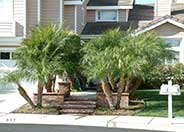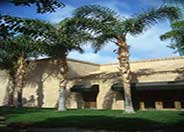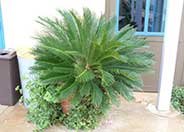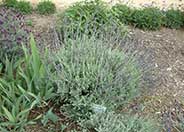
Common name:Pygmy Date Palm, Roebelin Palm
Botanical name:Phoenix roebelenii
This tree will grow to about 10' tall and has dark green, spiny petiole foliage. It does well in full sun to heavy shade; it likes moderate to heavy irrigation, but can take periods of dryness.

Common name:Queen Palm
Botanical name:Syagrus romanzoffianum
This palm has a very straight trunk to about 50' in height. It has arching, feathery, bright green, glossy leaves that can be 10'-15' long. It is fragile in heavy winds and a fast grower. It will become damaged in temperature below 24 degrees F.

Common name:Sago-Palm
Botanical name:Cycas revoluta
Sago Palm resembles small palms; it is evergreen. It can slowly grow to 10'. It is used for a tropical effect and also looks great in planters. In the low desert, light shade and additional moisture are best. Side sprouts can form multi-trunked individuals. Apply fertilizer at leaf expansion. This plant has few pests.

Common name:Goodwin Creek Grey Lavender
Botanical name:Lavandula 'Goodwin Creek Grey'
Lavandula 'Goodwin Creek Gray' is an evergreen shrub. This dense foliaged plant grows to 5' high and 3'-4' wide, with silvery leaves that are toothed at the tips. Deep violet-blue flowers from spring to late fall.
Maintenance Tips
Lavandula 'Goodwin Creek Grey' is a very large lavender that matures into a dome, 5' tall and wide. The tall flower stalks emerge in the spring and are very attractive to bees and butterflies. This is one of the most dramatic of the lavenders and is frequently found in California native gardens. To keep the maintenance as low as possible, plant it in a sunny location with the space to reach its full mature size. This plant is described in many publications as only growing to 3' tall, so it is often not given enough space to grow and becomes a victim to sheering or other poor pruning habits. Once it is poorly pruned and loses its natural shape, it rarely returns to the lovely dome it could have been. Once the flowers have faded, the spent stalks can be deadheaded to keep the shrub looking tidy and encourage additional flowers. Woody shrubs tend to become dense with lots of cross-branching, so thinning out the branching and allowing sunlight to the interior will benefit the plant and will encourage new, green growth. This shrub can take more aggressive hedging, cutting back by about a third in the winter to keep the nice dome shape.
Photographer: GardenSoft
Incorporate compost 6" into your soil to retain water, reduce compaction, feed earthworms, and provide valuable nutrients to your plants.
Develop healthy soil for plants that are vigorous and naturally pest-resistant.